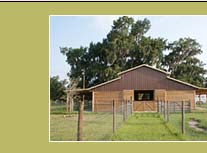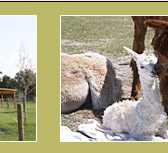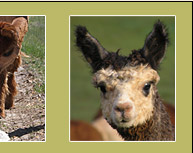Questions and Answers About Alpacas
 Q. What exactly is an alpaca? Q. What exactly is an alpaca?
A. Alpacas and their close llama relative are members of the scientific family camelid, as are camels, guanacos and the extremely rare vicuna. The alpaca was imported to the U.S. in the 1980s from South America (Peru, Bolivia and Chile). There are two types of alpaca – the Huacaya (pronounced wah–kay–ya), and the Suri (pronounced sir-ee). The main difference between the two is in the appearance of their fiber. The Suri has fine fiber that grows downward on their body and appears to hang in dreadlocks from their body. The Huacaya has very crimpy fiber, which gives them a woolly and round appearance. Both types come in a wide variety of natural colors – 22 different ones in fact - ranging from bright white to true black with all shades of brown and gray.
Q. What is a cria?
A. A cria is the name for a baby alpaca. Weaned crias are known as weanlings. In Spanish the adult males are known as machos and the adult females are hembras. We also refer to them as dams and sires.
Q. What do you do with alpacas?
A. Alpacas are primarily raised for their fleece as well as breeding purposes. Alpaca are a “fleece” animal so that is their primary purpose of existence. There is a market for their fleece and products made out of their fleece. Income from sale of their fleece and/or products is typically adequate to cover the cost of care (food, medical, etc.). We also show the alpacas at nationally sanctioned shows as well as enter their fleece (not take them to a show) into fleece shows.
Q. Do they make good pets?
A. Many people do have alpacas purely as companion animals – and there must be at least 3 of the same gender kept together. Males and females are kept in separate pastures and ideally not to share a fenceline. They are generally not ideal for “pets” similar to dogs BUT if owners are realistic in their expectations they are wonderful animal to raise. They are more cat-like than dog-like in their attitude towards us humans - somewhat timid, but very curious and intelligent, and with handling and time most will eventually eat out of your hand, and can be trained to lead by halter. They do not really like to be held and "petted" and are especially sensitive to being touched on their heads, ears and legs.
Q. How much do they cost?
A. Prices range from around $500 for a fiber male (not for breeding) to many thousands of dollars for top quality breeding males and females. Females can be worth anything from a thousand dollars to 2 figures depending on their age, quality and breeding history. The girls are valuable because of their ability to produce crias which can be sold when at an appropriate age providing return on the initial investment. Top quality males with have a high value as breeding animals also and can provide their owners income via stud service fees.
Q. What if once I have made this investment the population explodes and decreases the value of the animals?
A. While the future of an alpaca investment cannot be guaranteed any more than you could guarantee an investment in the stock market, it does appear to be more predictable. Population explosion is not possible because the registry for alpacas is now closed in the U.S. which means imported animals can no longer be used for registered breeding stock. In addition, alpacas have a long (11-12 months) gestation period and typically give birth to a single offspring. At this point, the industry remains healthy with demand for animals and fiber.
Q. Are alpacas dangerous?
A. Absolutely not! They are wonderful, gentle animals - very safe for adults and children alike (in fact they are often very curious and enchanted by children). Alpacas do not possess the teeth, horns, hooves or claws to do any harm. They don't bite, they don't butt and it is not common for them to kick. However, they are sensitive around the back legs and will instinctively kick out if they sense a threat from the rear but they do have soft padded feet so injury is not likely.
Q. Do they spit like llamas?
A. Yes - they can spit. The spitting is actually a form of communication between the alpacas. It is how crias and young adults learn to interact appropriately in a herd. It could be viewed as their defense mechanism but it’s not really – running is what they rely on for a defense mechanism. The spit is a fine spray of partially digested grass, not too pleasant smelling, but it brushes off once dry. The good news is that alpacas rarely spit at people. If a person does get hit it is usually because they got caught in the crossfire between two squabbling alpacas.
Q. What do they eat?
A. Alpacas are ruminants which means they chew cud like a cow or a deer. The bulk of their diet is made up of good quality grass hay (Orchard is ideal) and/or pasture grass. They are from a harsh climate so they are well adapted to maximize their intake of their food. There are a number of commercially available alpaca feeds, but these should be rationed as a vitamin and mineral supplement. Their primary food source should always be good quality grass and hay. Here in the south, alpacas just like any grazing livestock, tend to drink a lot of water so access to clean, fresh drinking water is a must at all times. Electrolytes is ideal to put in some of the water buckets/troughs but ensure all have access to water with no electrolytes.
Q. Are they easy to keep and care for?
A. Yes alpacas are relatively easy to keep and care for. They are small and easy to handle. They are hardy animals and are highly resistant to disease. A simple protocol of having fecal tests done on a regular basis (e.g., quarterly) and keep an eye on their weights is a good way to keep on top of their health. Any change in behavior or eating habits is also a red flag that something may be bothering them. The need for veterinary care is minimal with alpacas. They do not challenge fences, and any fence suitable for sheep is suitable for alpacas - barbed wire should be avoided due to potential for fleece damage. A barn is nice but not necessary for their comfort. A simple three sided run-in so they can get out of the elements is recommended. Alpacas come from a harsh climate naturally so they are pretty tolerant of cold conditions but do not fair as well in extreme heat, hence the need for a shelter to provide shade. Here in FL, fans are a necessity and can provide some comfort to them during the highs of summer. Another key to keeping them comfortable during the hot summers is to take a water hose and wet their bellies and chests to bring their core body temperature down. Never wet the top of an alpaca back since it traps the heat in. Their earth-friendly padded feet do no damage to pastures, as found with other livestock.
Q. How much land do they require?
A. Alpacas are ideal if you don't have a lot of acreage. You can comfortably graze between 3 to 5 alpacas on one acre. Although it is not necessary, optimally you should have twice the required acreage so that you can rotate your pastures (i.e. two acres for 5 to 8 alpacas). In addition, it is recommended to always keep males (7 months of age and older) and females in separate pastures as well as not share a fenceline. Your males will much calmer if they cannot touch noses with female alpacas.
Q. Do they get along with other animals?
A. Alpacas are naturally wary of members of the canine family but other than that they do fine with other livestock. They can be easily kept in the same pasture as sheep and llamas. Caution should be used when pasturing alpacas with horses and/or cows due to the risk of the alpacas being injured if kicked. It is our belief housing alpacas with goats is not ideal due to the fact they share the same internal/gut parasites as alpacas. The medicated feed typically given to goats can be toxic to alpacas.
Q. What is involved in breeding and birthing?
A. Female alpacas are ready to breed 24 to 36 months of age depending on the physical stature and maturity level of the alpaca. They do not have a breeding season and can usually be mated at any time of the year. However, in the south alpacas are usually bred in late December thru end of May timeframe to avoid the heat of summer for the alpaca’s last trimester. Alpacas require 'live breeding' - artificial insemination is not possible because like cats and rabbits they are induced ovulators, which means that the act of breeding causes them to ovulate. The gestation period is approximately 11.5 months. Births are usually trouble free and most often occur in the middle of the day. Typically, no help is needed in the birthing process. However, breeding and raising cria is a whole other facet of infrastructure and nutrition needs.
Q. How often do they need to be sheared?
A. Alpacas are usually shorn once a year for their own comfort and is a requirement for alpacas and llamas. In the southern states, huacayas are typically shorn 2x a year. Depending on the density of the fleece each adult alpaca will usually produce from 3 - 10 lbs per year. Some of the high quality stud male's production can often be higher.
Q. What is so special about their fiber?
A. The fleece shorn from alpacas is hair not wool. It has a silky shine, and super soft feel, yet contains no lanolin and is hypoallergenic. People who have allergies associated with sheep's wool can comfortably wear luxurious alpaca garments. Alpaca fiber is much stronger and yet finer than sheep's wool. It is as soft as cashmere and three times warmer than sheep's wool. Evolving in freezing temperatures at high altitudes has given alpacas more thermal capacity in their fiber than any other fiber bearing animal. Alpaca fiber is officially recognized in 22 different natural colors and is highly prized. It can be processed into high quality fashion garments such as socks, scarves, gloves, suits, jackets, skirts and coats, as well as soft, light, warm sweaters. Because of its thermal properties coarser fibers may also be used in quilt filling. The international market for alpaca product is enormous with demand always exceeding supply.
Q. What is an Accoyo alpaca?
A. The name "Accoyo" refers to an Alpaca that has been bred at Estancia Accoyo farm in Peru. In the US the name "Accoyo" refers to alpacas imported from the estancia or to direct descendants of these imports. An alpaca is considered to be a pure or full Accoyo if its parents are both pure Accoyos. A more important question would be why breeders so highly prize this particular line of animals. The answer lies with the breeding program of Don Julio Barreda, the owner of Estancia Accoyo, which has created superior quality animals. Estancia Accoyo is located in Macusani, Peru at 15,000 feet above sea level. Since there are few places in the world where animals of any kind are raised at that altitude, it follows that only hearty animals prosper. And since alpacas are valued primarily for their fleece, it is easy to assume that they would have superior coats. This has been proven at alpaca shows in Peru and the United States. According to National Geographic Magazine, Maccusani, Peru, is the world center for Alpaca fiber production. While there are other ranches on the Alta Plano of Peru, it is Senor Barreda at his Estancia Accoyo who has controlled and maintained the breeding program that has made these animals world famous. For over fifty years he has been breeding only those alpacas that meet his very exacting standards for conformation and fiber fineness, density and uniformity. In his own words: "I have been able to breed well-defined Alpaca phenotypes with an absence of atypical animals. I attribute Accoyo's success at breeding Alpacas with superior production qualities to the father's lineage."
Q. How do I get started raising my own alpacas?
A. First of all we recommend visiting as many farms and talking with as many breeders as possible. Almost all alpaca breeders are more than willing to share their knowledge and experience with potential new breeders - we LOVE to show off our alpacas! This is a great way to learn lots of "dos and don'ts" from people who have already done the legwork. Many people buy a couple of geldings or intact males to begin with and once they feel confident that alpacas really are easy to care for and an utter joy to be around, they take the next step to the larger financial investment of breeding animals. I don’t suggest this, but other people just dive right in. Whatever your comfort level, there are breeders out there who would love to help you succeed.
Contact us for a farm visit to get you started on your journey. |





